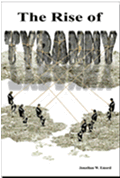By
Marilyn M. Barnewall
November 8, 2009
NewsWithViews.com
One of the great problems in today's synthetic world is the inability of people to get a firm grip on reality. Whatever world you live in, real or imagined, it seems real to you. How can you determine if you're living in a real or imagined world?
To those who work hard each day, or watch their family break apart, or become a victim of crime, their worlds seem very real. Truth is a great revealer of reality. Failure makes clear that someone made a faulty assumption and it resulted in an altered reality.
If I'm living in an unreal world, how do I know truth when I find it? Good question! Your search for truth may find that your business model has conflicts of interest, lost profits, and, sometimes, downright fraud and deception. Your personal model, when evaluated, may provide some hard-to-swallow truths, too. One way to avoid losing your path is to write (or hold in your heart) personal and business philosophy statements. Evaluate what happens in your life periodically against your stated intentions.
When a business model is created on the basis of "what will the market bear?" rather than "what is the best way to meet consumer needs?" a synthetic business model results. The "what the market will bear" philosophy leads to roads destined to destroy success, both personal and business.
Derivatives, which are synthetic, and the irresponsible way in which they were created and sold, is a good example of "what the market will bear" failure. The "market will bear" a variety of abuses… for the short term. If you seek short-term success and long-term failure, "what the market will bear" is an option. Society, however, is a long-term personal and business adventure. It does not treat kindly the short-term philosophies of greedy people.
When solving major problems, keep asking questions that take you to the core. Keep asking, "And what causes that?" until you know you’re at the core. Until then, core problems remain unidentified, long-term and realistic solutions remain hidden. Until people learn to find the most basic (rather than the easiest to identify) reason for failure, reality and the solutions to social, political, personal and business problems elude us.
What is happening to America today is a dose of reality. When your expectations say one thing and your reality says another, you can assume you're living in a synthetic world.
To identify core problems, go back in history and find where negative changes began. If the basis for American success is life, liberty and the pursuit of happiness, we can safely say we are failing. When did an increase in crime, the loss of family stability, the increased cost of living, class envy, political divide and conquer methods, increased cost of doing business, increased size of government, and the loss of personal freedoms begin? When did loss of personal accountability occur? When did we lose our Rule of Law? What needs to be changed to get it back?
We need to seek the core problem in business, politics, education, poverty, media, capitalism, transportation, the environment… you name it. Change, it seems, is heading our way. But will it improve our lives? Or, will it lead to even lower depths of short-term failure and lost perspectives of long-term success?
Government wants to give the Federal Reserve System more power even though it seemingly was incapable of identifying dishonesty in the structure of derivatives, real estate bubbles, high-tech market bubbles, and numerous other problems that were quite apparent to others who have pointed them out for years.
Regardless, government wants to centralize regulatory authority in an organization that is part of the core problem. It is a king-sized error. It puts the fox in charge of the hen house.
It is time to stop defining our multitude of problems – stop asking why, and ask when and what more often. Begin seeking solutions. Problems can be defined to death with no core cause sought and no practical solutions coming from the rubble of historic errors. That’s where the old “If you don’t learn from history…” axiom comes from. All problems have solutions. We need to stop tiring ourselves out defining problems. Spend the energy seeking solutions.
Regarding our business, banking and economic problems, we need to accept the fact that the standards we have been using to gauge success are wrong. If they were right, we would not have a failing/failed economy, society, and business community that produced Enron, Bernie Madoff, Freddie Mac, Fannie Mae, too-big-to-fail banks, and other short-term successes and long-term failures. All of them were - and are - supported by corrupted government and its policies and regulations. We need people with attitudes, knowledge and government support to do their jobs properly.
Perhaps government has objectives not in synch with a successful capitalist economy? Perhaps government prefers a socialist Democracy to a freedom-loving Republic? Maybe government wants one world order rather than national sovereignty? Nothing happens by accident, including the mess we, the People, have allowed. It’s time to clean up the mess.
There are easily identified core problems at the base of social, economic, political, educational, media, and Constitutional issues: Attitude, character, ethics, poverty, no accountability, and a lack of strong leadership and personal integrity.
One "core problem" I identified when I was doing profit analysis of America's banks was traditionalist accounting that did not look deeply enough into profit-generating areas so better financial support of future growth could occur. I believe the same problem exists throughout the business, political and social communities. The problem can be defined by the difference between “cost efficiency” and “cost effectiveness.”
Cost efficiency maximizes all assets to better serve the source of profit: customers (or taxpayers or stockholders – or, families). Cost effectiveness is usually an inefficient use of funds to serve and protect the same profit sources – customers, etc. It results in what is called “creative destruction.” That, in turn, results either in failure or the need to cut costs.
Cost effectiveness says "Look, we know this product has a problem (perhaps a defective tire or a car that explodes when hit in the rear or low-cost products from China that destroy our health, or a derivative that is a weapon of mass destruction, but on which we can, for a short time, earn huge profits). But the public likes the product and so the market will bear the short-comings and we can earn profits until the truth is discovered. At that point, we'll pay a small penalty in relationship to profits gained, scrap the product, get rid of the jobs required to produce it, and come out with another new product." Public trust, of course, erodes under such conditions. We've certainly experienced such business philosophies. Investment banks are players on cost effective turf as are pharmaceutical and auto companies.
When I first started analyzing profits, I was surprised by the number of banks that did not know the per dollar cost of deposits and loans, the core of their cost of doing business. Even more important, they ignored the cost - and profit - per customer. They knew departmental profit overviews, but did not go to the core of cost and profit production. As a result, they often made bad decisions funding future growth. Cost effective companies think bigger numbers mean "more profitable." If Division A shows income of $100 million and Division B shows income of $10 million, Division A must be more profitable, right? Viewed on a per customer basis, however, a smaller group with lower total income but higher per customer profits is far more cost efficient with greater profit potential if financial support is given so growth can occur.
Whether a publicly held or a privately owned company, profits should always be calculated in relationship to risk. The best way to allocate costs for the future is to find out which person or group produces more profits per dollar of cost. A core question for public education: Why is it that in national tests, home-schooled kids get higher grades at an average annual cost of $500 per student than public-schooled kids who cost $9,000 per year? Perhaps it's the public school cost for condoms and cucumbers… or too many administrators?
One way companies and governments (and people) lose perspective as they age is they stop asking the right questions. Looked at from the perspective of profit in relationship to cost however, that barrier is removed. Personal relationships are the same. Though “profit” and “cost” are defined differently, the concept remains the same. In business and personal relationships, the core question must always be: Are costs becoming too high for the risks being taken and the profits being realized?
If the answer is “yes,” it is time to analyze some core problems and ask “When did it happen?” And, “What can be done about it?”
Are you running your life and your business cost efficiently? Or are you in a cost effective mode? If you’re into cost efficiency, you are probably living in the real world. To be cost efficient you must ask yourself questions every day that take you to the core of problems. If you’re into cost effectiveness, the chances are pretty good that you’re living in a synthetic world. You push things to the limit – finances, trust, loyalty, truth, costs, ethics – and figure profits will justify losses you may take as a result of your choices. And, for a while, they may.
|
Subscribe to the NewsWithViews Daily News Alerts! |
The unfortunate thing is, once people compromise the things of the real world to gain access to make believe, they seldom regain access to the real world without paying substantial penalties… the kind that make you say “ouch!”
� 2009 Marilyn M. Barnewall - All Rights Reserved
Sign Up For Free E-Mail Alerts
Marilyn Barnewall received her graduate degree in Banking from the University of Colorado Graduate School of Business in 1978. She has authored seven non-fiction books about banking, two are listed at Oxford and Cambridge University libraries in Great Britain. Her current book, When the Swan’s Neck Breaks, details the banking problems she foresaw in 2006. Of the 24 predictions made in the book, 22 have happened. It is fiction but readers refer to it as docu-fiction.
Barnewall was named one of America's top 100 businesswomen in the book, What It Takes (Dolphin/Doubleday; Gardenswartz and Roe) and was one of the founders of the Committee of 200, the official organization of America's top 200 businesswomen. She can be found in Who's:Who in America (2005-08), Who's Who of American Women (2006-08), Who's Who in Finance and Business (2006-08), and Who's Who in the World (2008).
Web site:
E-Mail: marilynmacg@juno.com
















